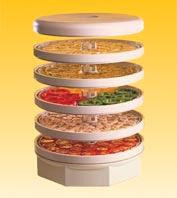
Drying is a method of food preservation that works by removing water from the food, which prevents the growth of microorganisms and decay. Drying food using the sun and wind to prevent spoilage has been known since ancient times. Water is usually removed by evaporation (air drying, sun drying, smoking or wind drying) but, in the case of freeze-drying, food is first frozen and then water is removed by sublimation.
Bacteria and micro-organisms within the food and from the air need the water in the food to grow. Drying effectively prevents them from surviving in the food. It also creates a hard outer-layer, helping to stop micro-organisms from entering the food.
Develop an experiment to:
1. Determine how much water is removed during the dehydration process?compare, contrast tastes of original and dehydrated foods
2. Do dehydrated foods taste differently to non-dehydrated foods?
3. What foods can be dehydrated?
4. Bacteria: how do we know if a food product has been effected? What are the consequences of eating food infected with bacteria
5. Do hydrated foods 'lasts' longer than non-dehydrated foods?
Students Learn to:
* Demonstrates safe practices in the use of equipment, materials and tools
* Maintains and cares for equipment, materials and tools
No comments:
Post a Comment